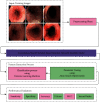Atom Search Optimization with the Deep Transfer Learning-Driven Esophageal Cancer Classification Model
- PMID: 36156959
- PMCID: PMC9507698
- DOI: 10.1155/2022/4629178
Atom Search Optimization with the Deep Transfer Learning-Driven Esophageal Cancer Classification Model
Retraction in
-
Retracted: Atom Search Optimization with the Deep Transfer Learning-Driven Esophageal Cancer Classification Model.Comput Intell Neurosci. 2023 Aug 9;2023:9870789. doi: 10.1155/2023/9870789. eCollection 2023. Comput Intell Neurosci. 2023. PMID: 37600268 Free PMC article.
Abstract
Esophageal cancer (EC) is a commonly occurring malignant tumor that significantly affects human health. Earlier recognition and classification of EC or premalignant lesions can result in highly effective targeted intervention. Accurate detection and classification of distinct stages of EC provide effective precision therapy planning and improve the 5-year survival rate. Automated recognition of EC can aid physicians in improving diagnostic performance and accuracy. However, the classification of EC is challenging due to identical endoscopic features, like mucosal erosion, hyperemia, and roughness. The recent developments of deep learning (DL) and computer-aided diagnosis (CAD) models have been useful for designing accurate EC classification models. In this aspect, this study develops an atom search optimization with a deep transfer learning-driven EC classification (ASODTL-ECC) model. The presented ASODTL-ECC model mainly examines the medical images for the existence of EC in a timely and accurate manner. To do so, the presented ASODTL-ECC model employs Gaussian filtering (GF) as a preprocessing stage to enhance image quality. In addition, the deep convolution neural network- (DCNN-) based residual network (ResNet) model is applied as a feature extraction approach. Besides, ASO with an extreme learning machine (ELM) model is utilized for identifying the presence of EC, showing the novelty of the work. The performance of the ASODTL-ECC model is assessed and compared with existing models under several medical images. The experimental results pointed out the improved performance of the ASODTL-ECC model over recent approaches.
Copyright © 2022 Nawaf R. Alharbe et al.
Conflict of interest statement
The authors declare that they have no conflicts of interest.
Figures















Similar articles
-
Machine learning applications for early detection of esophageal cancer: a systematic review.BMC Med Inform Decis Mak. 2023 Jul 17;23(1):124. doi: 10.1186/s12911-023-02235-y. BMC Med Inform Decis Mak. 2023. PMID: 37460991 Free PMC article.
-
Ensembled CNN with artificial bee colony optimization method for esophageal cancer stage classification using SVM classifier.J Xray Sci Technol. 2024;32(1):31-51. doi: 10.3233/XST-230111. J Xray Sci Technol. 2024. PMID: 37980593
-
Towards laryngeal cancer diagnosis using Dandelion Optimizer Algorithm with ensemble learning on biomedical throat region images.Sci Rep. 2024 Aug 24;14(1):19713. doi: 10.1038/s41598-024-70525-0. Sci Rep. 2024. PMID: 39181918 Free PMC article.
-
Hybrid Rider Optimization with Deep Learning Driven Biomedical Liver Cancer Detection and Classification.Comput Intell Neurosci. 2022 Jun 30;2022:6162445. doi: 10.1155/2022/6162445. eCollection 2022. Comput Intell Neurosci. 2022. Retraction in: Comput Intell Neurosci. 2023 Sep 14;2023:9874945. doi: 10.1155/2023/9874945. PMID: 35814569 Free PMC article. Retracted.
-
Deep Learning Computer-Aided Diagnosis for Breast Lesion in Digital Mammogram.Adv Exp Med Biol. 2020;1213:59-72. doi: 10.1007/978-3-030-33128-3_4. Adv Exp Med Biol. 2020. PMID: 32030663 Review.
Cited by
-
An endoscopic ultrasound-based interpretable deep learning model and nomogram for distinguishing pancreatic neuroendocrine tumors from pancreatic cancer.Sci Rep. 2025 Jan 27;15(1):3383. doi: 10.1038/s41598-024-84749-7. Sci Rep. 2025. PMID: 39870667 Free PMC article.
-
Machine learning applications for early detection of esophageal cancer: a systematic review.BMC Med Inform Decis Mak. 2023 Jul 17;23(1):124. doi: 10.1186/s12911-023-02235-y. BMC Med Inform Decis Mak. 2023. PMID: 37460991 Free PMC article.
-
Retracted: Atom Search Optimization with the Deep Transfer Learning-Driven Esophageal Cancer Classification Model.Comput Intell Neurosci. 2023 Aug 9;2023:9870789. doi: 10.1155/2023/9870789. eCollection 2023. Comput Intell Neurosci. 2023. PMID: 37600268 Free PMC article.
References
-
- Kawahara D., Murakami Y., Tani S., Nagata Y. A prediction model for degree of differentiation for resectable locally advanced esophageal squamous cell carcinoma based on CT images using radiomics and machine-learning. British Journal of Radiology . 2021;94(1124) doi: 10.1259/bjr.20210525.20210525 - DOI - PMC - PubMed
Publication types
MeSH terms
LinkOut - more resources
Full Text Sources
Medical
Miscellaneous

